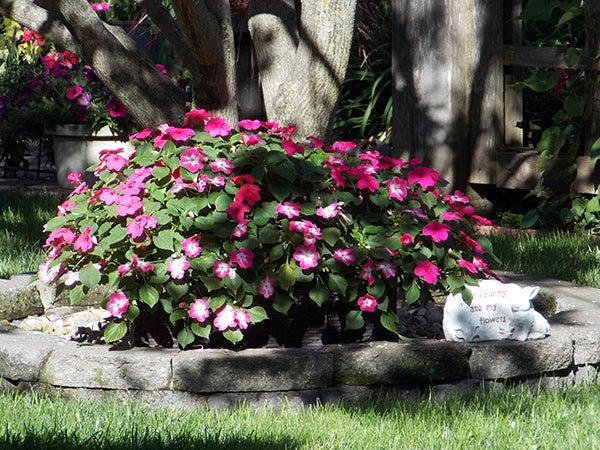Gardening challenges, remedies
Published 9:00 am Sunday, April 20, 2014

Bedding impatiens, pictured in one of Carol Lang’s gardens, were devastated by a powdery mildew virus in 2013. – Carol Lang
Serendipity Gardens by Carol Hegel Lang
Over the past few years those of us living in the Midwest have been faced with some gardening challenges that have made us scramble to find other plants to replace those with disease. In 2012 I met my first challenge that threatened my butterfly garden when the aster yellows phytoplasma infected my coneflowers. After reading about this disease, I pulled out all of my coneflowers because I didn’t want to spread it to those that were not yet infected. The only plant I could think of to add was Joe-pye weed that would attract both butterflies and bees.
In 2013, I again planted more coneflowers and this time I did not find the disease present in any of them.
This year I will be watching carefully to see if the disease comes back because I would be very sad to lose my coneflowers again as they are a mainstay in my butterfly gardens.
In 2012, my sister, who lives in Texas, sent me an article about powdery mildew, or, Plasmopara obducens, in bedding impatiens, impatiens wallerina. The article told about the Dallas Arboretum losing over 20,000 plants to the disease and in 2011 Europe was totally devastated by this disease.
So, when spring came and I found impatiens in all the garden centers, I was surprised. I asked several of our local greenhouses about it and they just told me to watch them closely if I planted them. It wasn’t until August that I started noticing one of the containers looking a bit wilted and I thought, possibly, I had just forgotten to water it the day before so I watered it and moved it to a location closer to the house.
It was only a day later, and the leaves started to show signs of yellowing and wilting so I knew that it had attacked my impatiens. The only remedy was to dispose of the plants in a garbage bag and take the plants with the soil to the landfill since you don’t want to add this to your compost pile as the disease will stay in the soil for five years.
All of mine were planted in containers, so then I watched the other containers to see if they showed signs of the disease and, sure enough, the ones in the front yard also were turning yellow. My next step was to empty all of the containers and dispose of the plants and soil. This is an airborne disease, so even if you didn’t have plants that became infected, your neighbor may have and those little contaminates would have been spread by the wind or even birds that came in contact with the plants.
Impatiens have been the plant for color in shady areas for many years and now that we can’t plant them, people are asking me what can they plant? First, you need to look at the location you will be planting in and how much shade it actually receives. If you are looking for annuals to use in containers, my first choice would be begonias and then coleus. Both of these come in a wide variety of colors. You can also go with sunpatiens unless you are planting in heavy shade where they won’t bloom quite as prolifically.
Some other favorites of mine to plant in shady areas are browalia, a gorgeous blue color; viola, which does very well and the newer varieties are blooming all summer for me if kept well-watered and fertilized; caladiums; lobelia and fuchsia, a great plant for hanging baskets.
If you can alter the type of shade you will be planting in by limbing up the trees to give a bit more light, you can try almost any of the flowers that require sun to partial shade. I love the new snow princess lobularia, or, alyssum, and have found it does quite well with partial shade. Sometimes you just have to experiment with flowers to see if they will perform well for you in that location. Everyone is going to have to change their way of thinking and planting now that bedding impatiens are no longer a plant choice.


